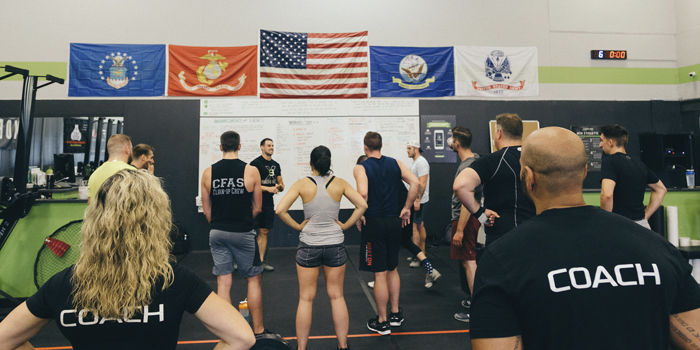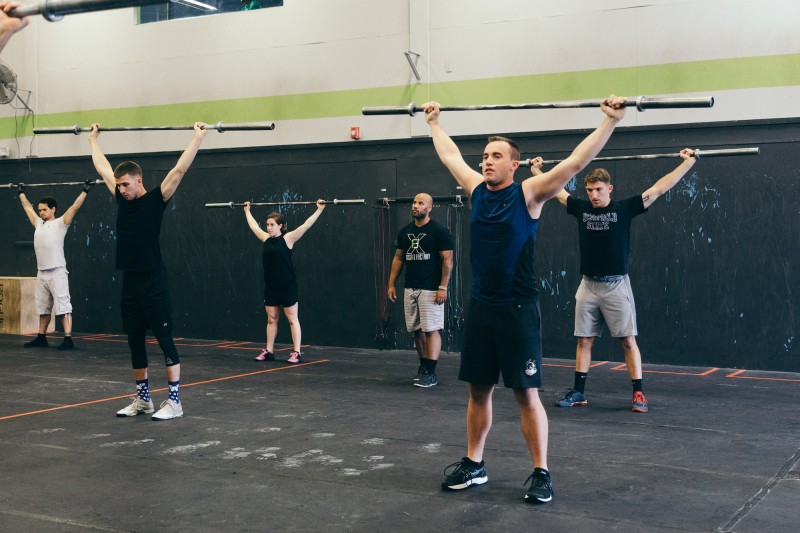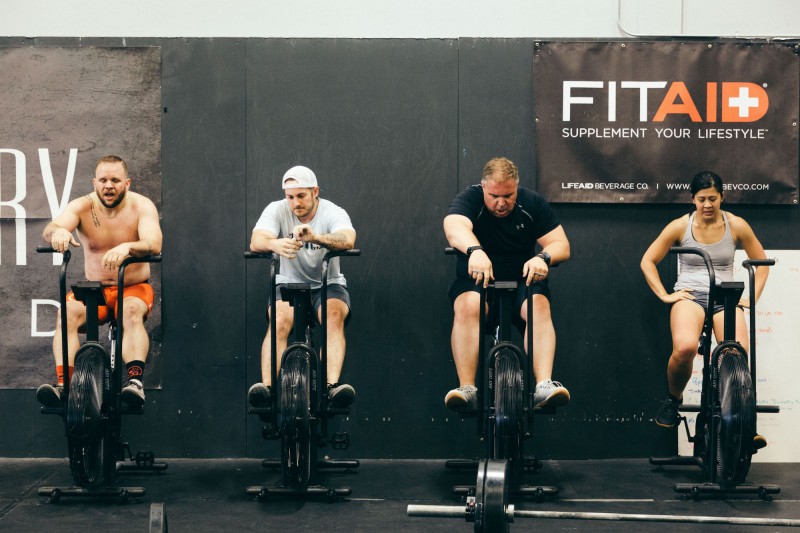
The crux of this article is that coaches need to be smarter with exercise selection, volume prescriptions, and distribution of high-intensity work. With the limited amount of time a client spends at your facility each week, the question to be asked is this: are you really giving your clients the tools they need to succeed? All too often we see coaches prescribe too much volume, too much intensity, too many times a week. At the end of the day, 99.9% of people who show up at a box do not want to increase their snatch or compete at the games. Most simply want to have more energy and look better in a bathing suit.
RECENT: A Training Cycle Alternative for Group Athletes
It always blows my mind to see gyms prescribe inordinate amounts volume with movements like GHD sit-ups and snatches. Let's face it: snatches aren't going to do shit for your clients' body composition, and will more than likely result in an injury. And I'm not even sure how or why the GHD sit-up even became a viable exercise choice. Please do your clients a favor: keep it simple, and give them what they need to get closer to their goals.
Remember when it was cool to be laying on the ground dead after each training session? When I first started box programming, being "dead" after each workout was commonplace. Doing more, going harder, and feeling like shit was the standard. Eventually, I started to dread the training and wondered if there was a better answer. Having a background in the conjugate method, I knew we could make some better choices and have a plan in place that allowed us to avoid overtraining but still experience the best aspects of CrossFit. Many of your clients will probably think that they need to train like a professional CrossFit Games athlete or kill themselves daily as well, but it's our job to educate our clients as to why that's not practical, nor does it bode well for long-term health and success. It's no mystery that your new clients probably want to be smoked after each class they take at your box, but you know better than that. It's likely you'll have people complain about not being "smoked" during every single training session, but if you're 100% confident that what you're delivering to your clients is going to allow them to get what they need to be successful, then the "loud minority" should not matter.
With that said, I've seen coaches focus on the few unhappy clients and change their approach, thinking that just because a few people are unhappy, everyone is unhappy. This is a huge mistake and, more to the point, it's rarely the case. At no point do you want to adjust your core principles for clients who really don't know their asses from their elbows when it comes to programming. More than a decade before box programming became mainstream, Louie Simmons developed the conjugate method for powerlifters. This concurrent system of fitness has some parallels with CrossFit. The conjugate method successfully helps athletes develop their work capacity, improve their limiting factors, and is useful for athletes of all abilities, not just powerlifters. As a whole, the system is constantly varied, much like CrossFit.
For both novice and competitive box athletes, this system of training works wonders. Additionally, this system works incredibly well for regular folks that attend a local box and simply want to look and feel better. The conjugate system has helped us provide the framework for our programming that we provide to boxes all over the world, which you'll see represented in a week of programming below. This system allows us to effectively blend strength and energy systems work as well as ensure we are building our clients' foundations properly. Below are things that should be staples at every CrossFit box and can certainly be beneficial for athletes of all abilities. If there is one thing I've learned from Louie, it's that a pyramid is only as big as its base, which means that if we are not building our clients' foundations with measures like sled work and special exercise work, then we're doing our clients a disservice.
A great example in box programming that often comes to mind is those who perform kipping pull-ups before being able to do a strict pull-up. Would you let your clients perform a max deadlift before knowing how to hip-hinge? I doubt it.
Less High-Intensity Work and More Aerobic Work
It's been proven that athletes with higher levels of aerobic capacity live longer. Additionally, our clients are already chronically under-recovered and over-stressed. Aerobic work helps us improve recovery, thereby allowing them to engage in higher intensity training without the risk of overtraining. I've seen a fair amount of burnout occur amongst athletes who go to boxes that program high-threshold work too often (for some this is a daily occurrence).
At first, people get better and think it's great. Eventually, people lose motivation and become less willing to be put through the ringer with random programming. This is when many folks cancel their membership and start looking elsewhere. An easy solution is performing more work that does not require your best effort or work that is not scored. The good news is that there are a variety of ways this work can be done, as we are only limited by our imaginations. As long as your client's heart rate stays in the correct range, they'll get what they need to be successful.
Assistance Exercises
When I first started programming for other boxes, people would be confused as it was no mystery that performing things like biceps curls or triceps extensions was labeled "non-functional." Although this is an easy objection to overcome, people get so fixated on dogmatic views without actually knowing what they are talking about. I'm sure if you read on elitefts you don't need a review of why assistance work is important, but for folks at a CrossFit box, the conversation between a coach and client may look something like, "You want to do a strict pull-up and want better arms, right? Well, direct biceps work is going to help you with that. How does that sound?"
Loaded Carries
The list of benefits of performing loaded carries is endless, but even so many coaches fail to utilize them. From a conditioning standpoint, loading carries can be utilized as high-resistance aerobic training. Loaded carries are a staple in our programming because of their versatility and low-skill requisite. I'd much rather have an athlete perform a farmer's carry for sets than a full snatch. With the limited time you have with your clients, loaded carries offer a huge bang for the buck without the inherent risk of orthopedic injury.
Sled Work
Comparable to loaded carries in terms of low skill requisite and versatility, sled work is an amazing way to bridge the gap between training sessions. The uses include strengthening, recovery, and conditioning. Much like loaded carries, the sled can be used as a high-resistance aerobic tool as well. For about $120 you have a tool that 100% of your clients can benefit from, regardless of their level of ability. It will take about five sleds to satisfy a group as large as 15, but there aren't many pieces of equipment that can offer the same benefits for such a low cost. In comparison, a Concept 2 Rowing Machine costs about $900. You'll see between five and 15 of these at most boxes and maybe one to three sleds.
Box Squatting
The importance of the box squat is understated, and the fact that it works as a teaching tool for beginners as well as a tool to develop reversal strength for higher-level athletes makes it quite versatile. For instance, many newbies to box programming don't know how to hip-hinge properly. By using a tactile cue like a box we can teach these folks how to engage their posterior chain by sitting back to the box.
For advanced athletes, the movement breaks up the eccentric and concentric phase of the squat, forcing these athletes to develop reversal strength without the assistance of the stretch-shortening cycle. In addition, loading will be less than a standard back squat, making it a more joint-friendly option — not to mention easier to recover from.
A Week of Box Programming
A few things to keep in mind before viewing the sample below.
- Recovery Between High-Threshold Sessions: We need 72 hours recovery between our high-effort lifting and conditioning sessions. This ensures we avoid overtraining. You'll see this done between our upper and lower dominant sessions as well as high-threshold conditioning sessions.
- Strength Work Should Not Impair Conditioning Work: These two elements should coincide with one another in terms of movement pairing and energy requirements.
- Volume Prescriptions: I adhere very close to Prilepin's chart and have found this chart to be useful for heavier barbell conditioning pieces in addition to speed-strength work and strength-speed work.
- High Volume Band Work: This work is a staple in our programming, as we've seen profound effects with the inclusion of this work from both soft-tissue health and improving muscular deficits. High volume band work also acts as an equalizer in bringing balance to vertical pulling versus horizontal pulling.
- A Balanced Template: Of course you're going to have folks that show up on different days, have commitments outside of the gym, etc. With this approach, your clients will receive equals parts strength and conditioning, regardless of what days they show up. Moreover, the balance between energy systems training and strength systems is consistent so even if they decided to train five days straight they won't run the risk of burnout.
Day 1 — Max Effort Lower Focus
1. Sumo Deadlift from Two-Inch Mats — Work up to a heavy single with three-minute rests
2. Alactic Power Intervals — Eight to 10 sets of:
- 60-yard Prowler push sprint
- Two minutes of active recovery rest
- Goal each set is 100% effort. Use an empty sled.
3. Accessory Work — Accumulate 100 to 200 banded pull-throughs with 40 to 50 reps per set
Day 2 — Dynamic Effort Upper
1A. Speed Bench Press — 9 x 3 with 40% to 50%, 30 seconds rest, change grip every three sets
1B. Straight-Arm Banded Pulldowns —15 reps between each set of bench press, 30 seconds rest
2. Local Endurance Conditioning — EMOM 20:
- Minute 1: 10 Calorie Assault Bike
- Minute 2: Six to 10 Strict Chin-Ups
- Minute 3: 50-Feet Kettlebell Overhead Carry
- Minute 4: 20 Dumbbell Renegade Rows (Total)
- Minute 5: 40 Double-Unders
- Goal is 75-80% effort. All sets should be sustainable and should be completed unbroken.
3. Finisher — Accumulate 100 to 200 banded pushdowns, superset with 100 to 200 banded pull-aparts
Day 3 — Cardiac Output
Four Rounds:
- Three-Minute Bike
- Three-Minute Row or Jog
- Three-Minute Powerwalk — Light sled attached to your belt
- All done at 130 to 150 BPM
- Goal for today is low-effort, almost conversational (60% to 70% effort)
Day 4 — Dynamic Effort Lower
1. Wide Stance SS Yoke Bar Box Squat Against Bands — 8 x 3 with 50% weight plus 25% band tension, every 60 seconds, using a 13" to 14" box
2. Sumo Speed Pull Deadlift — 8 x 1 with 70%, every 60 seconds
Warm-up both box squats and deadlifts so you can proceed right from Exercise 1 to Exercise 2. This work should NOT take longer than 20 minutes.
3. GPP/Conditioning — Four Rounds:
- Double Kettlebell Front Rack Reverse Lunges x 10
- Heavy Kettlebell Farmer Carry x 100 feet
- Weighted Straight Leg Sit-Ups x 15
- Rest 2:00
- All sets should be completed in the same timeframe, 80% effort
4. Accessory — Reverse Hyper: 4 x 25, 90 seconds rest
Day 5 — Repetition Upper
1A. Dumbbell Bench Press, Neutral Grip — 5 x 10, rest 30 seconds
1B. Chest-Supported Dumbbell Rows: 5 x 10, rest 30 seconds
2. Lactic Power Intervals — Every Three Minutes for Five Sets:
- 10 Thrusters (challenging load, but able to be done unbroken)
- 10 Bar-Facing Burpees
- Each each set to max effort; each set should not take longer than 40 to 60 seconds to complete.
3. Accessory — Four Giant Sets:
- 30 Pushdowns
- 20 Standing Abs
- 10 Ketllebell Hammer Curls
Day 6 — Team Events
With a partner complete:
- 10 Minutes Max Distance Sled Pull (Heavy)
- 100 Wallballs
- 100 Russian Kettlebell Swings
- 10 Minutes Max Distance Barbell Carry (Five minutes front rack and five minute back rack)
- 100 Wallballs
- 100 Russian Kettlebell Swings
- One person works at a time. Split as desired with a 40-minute time cap.
Day 7 —Off
We do prescribe programming for the gyms that run classes on Sunday's. This training is more of a "total-body" approach and culmination of the entire week (microcycle) of programming.
One thing that is equally as important as anything we've discussed above is the atmosphere of your facility. Even the best-laid plan isn't going to keep people engaged if your coaches have shitty attitudes or bring their problems to work with them. Some of the days of programming listed above are purposefully not as "sexy" as what you may find at your average box, but nevertheless, the "boring" work has its place and will likely be more of what your clients need. A great coach can explain the relevance of this work and create a positive environment that your clients will inevitably buy into.
If you're a coach or box owner and you only take one thing from this article, let it be that we have a duty to be the expert and prescribe the work that our clients need to reach their goals and live longer. Remember that if your clients were deciding what the programming was, they'd probably be dead by week's end. You'll have some work to do to educate your folks on the difference between working harder and working smarter. You may even lose a few people that want to grind every day. Don't worry about them; that approach is flawed and will not get them to where they want to go in the long-run.
And more importantly, if you want to keep your clients progressing and healthy, have a plan that allows for built-in recovery, utilization of methods that actually work, and a simplicity of movement patterns. A snatch is NOT going to help your clients look better or live longer. It's really that simple.












